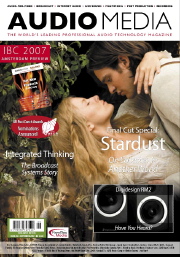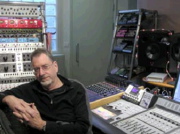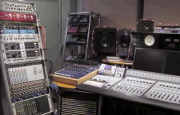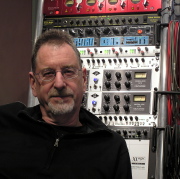Interview with Paul Mac - September 1, 2007
Many people keep tools in their basement. But how many have an achitect design a place for them? This is home studio... with knobs on. PAUL MAC reports.
“The business is changing a lot. Record company budgets are going down and there are more and more independent artists around. It’s a time for independents... independent from the traditional structure of making records, which is financed by a record company, or through sponsorship by a record company, if you want to call it that. Generally everybody’s got to be a bit more flexible now about how they go about recording.”
This statement is at the heart of the reasoning behind super-Producer Mick Glossop’s new home studio. However, just calling it a home studio seems like a terrible understatement, but what else is there? It’s at his home, and it’s a studio. Yet when you call in Munro Associates, an architect, and an army of implementors,‘home’is just geography.
“The main motivating factor for me is to be able to work on projects and work out financial arrangements whereby I can do lower budget projects – interesting projects – and work out a way of providing the facilities to do that,” begins Glossop. “So that’s really reflected in my standards for the place – I didn’t want to compromise at all... I didn’t want to feel that I was going to have to apologise for it only being a home studio.”
So far, Glossop has had a number of combos through the place - fourpiece bands, rhythm sections, and more. And while Glossop’s roots are firmly in the analogue world (30 years in the industry, and still counting), he has long been a digital user and has now settled on a Pro Tools rig with a ProControl surface as the primary weapon. The rest of the studio is a distillation of his invaluable experience, with a wide range of front end gear designed to ensure that what goes to disk, and what he hears, is the best it can be.
Home Improvements
Munro Associates took care of the design and acoustics of Glossop’s studio, and there was certainly a little more work done than a goodsized London terrace might normally expect. Construction started by digging down well below the level of the basement to allow room for a fully floating concrete floor with separate walls and suspended ceiling. All this, plus heavy duty double glazing where required, has left the neighbours without cause for complaint.
“If there’s a drummer in there you can just about hear a little bit of low frequency coming through in the lounge upstairs,” relates Glossop. “But that’s the only thing you hear.
I’ve cranked up the volume in here something incredible and you can hear hardly anything outside.
“One can read about acoustics and we know how it sort of operates, but unless you’re doing designs every day you really need to get experts to do it. I really believe in the idea of engaging the serves of people like that and listening to their recommendations and taking them seriously, which is what I did with Andy Munro.
“We had an architect involved as well, a guy called Laurie Bradley of CPA Architects, who was really good... To have someone to coordinate the whole thing was great and Laurie is an experienced guy. Creatively he was very contributory to the whole thing. I had all sorts of ideas and he would always look at the suggestions I had and say ‘well, have you thought about doing it this way’– and contributing. I would always recommend somebody gets an architect, because it’s certainly worthwhile.
One example of Glossop’s spacesaving solutions is the ‘quiet’ rack – where he keeps all the noisy gear. Inspired by a small computer isolation box, Glossop discussed the possibility of a larger scale version, integrated into the air-conditioning scheme, with Munro and the air-con’ company. Now the cabinet houses three computers, several interfaces, and other fan-cooled devices. The air-conditioning enters at the bottom of the cabinet, goes up past the equipment through perforated shelves, and gets distributed in the the main room out of the top. With the door closed, you wouldn’t know there were any fans; open it, and there's no doubt.
Optional Feature
The studio in Glossop’s basement isn’t intended to be the only place he’ll ever need. On the contrary, he expects to spend an amount of time at bigger facilities, working at big analogue desks – the way nature intended... “I’m working completely in the box here,” he says. “So if I’m mixing I’ll be mixing inside Pro Tools, and although that is working well I still feel the optimum – the best way to work – is through an analogue desk, using analogue outboard as well. ”Glossop displays no malice or apparent disparagement of the DAW age, but he does have a notion of an ideal environment, and indeed discounts ‘summing’ as an effective means to an analogue end: “it’s not just a question of going through the desk. Buying a 16-track line mixer doesn’t do it as far as I’m concerned. It’s not the summing part of a Neve desk that makes it sound like a desk, it’s the channels.” Over and above that, he also advocates an analogue environment with analogue dynamics, analogue EQ, analogue reverbs and plates, and more besides.
He continues: “Although ProTools is incredibly powerful, and I’ve got a ProControl system, which gives me hands-on fader control etc, it’s still quicker to use an analogue system... Having said that, I suppose I’ve been working on analogue desks for twenty or thirty years, so it is second nature to a certain extent. I don’t have to think about using an analogue desk, so 90 percent of the time I’m thinking about the sound and the creative process, and the mix, and the music. It’s all there in front of you.”
How Goes The Work?
So, it’s a home studio that’s built to commercial standards, accommodating as much of Glossop’s formidable experience, preferences, and ethic as is feasible, given the space restrictions. Yet it’s still a home studio: a tool. Glossop doesn’t view the place as a profit center as such – he is the value and the studio is the hardware. Therefore, there’s no direct pressure to make the studio pay for itself. “If there’s any pressure,” says Glossop. “it’s on me, to be involved in projects.”
And it sounds as though there’re no shortage of projects around. He’s hooked up with Rachelle van Zanten, an artist from British Columbia he describes as “a 21st Century Bonnie Raitt” and whose drummer apparently gave the studio isolation a very good testing; then there’s Naomi Bedford, friend of another Glossop mainstay, The Men They Couldn’t Hang. Another band with plans to work with Glossop are The Red lands Palamino Company, an ensemble that Glossop first heard on the Bob Harris Country Show; and then there’s Talitha McKenzie, who’s first album was one of the first projects that Glossop mixed in the new studio. A collaboration that also excites Glossop is one that he attributes to his myspace network – a singer-songwriter team called Storm Gordon.
The reason most of these, and especially the last one, are so significant is that however sort-after Glossop’s services are, he is constantly seeking new and exciting projects and not simply waiting for a call from a record company. It’s the double role that a Producer must embrace if he’s to carve a career these days – over lapping the studio practicalities with the commercial sense of a talent scout. It’s about going out and getting the work you want.
So where do you stop? Where do the lines between Producer, A&R, Promoter, Publisher, band member, and so on really lay? It’s only logical that if you have an on-going interest – especially a financial one – in the success of a project that you see it through as far as possible. Glossop draws the line at being a one-man record company, though does hint at interest in widening his professional horizons – only if the right partner came along – a collaborator who was as adept and comfortable outside the studio as Glossop is inside it.
The question remains though, of the Producer’s relationship with the artist, and the not insignificant detail of financial interest. To Glossop, this is just one of the many things that are changing in the music industry. Specifically, he says, it’s to do with the viewpoint of the Producer, and a willingness to work within lots of different types of relationships with artists. “That’s bound to involve the business side of things,”he continues.“it’s bound to involve how you get paid, the ratio between an advance or a fee, and the royalty situation. I work on a lot of lower budget projects whereby the advance is less and the royalties compensate for that. It’s a kind of deferred payment situation, which is very common in film work. That’s what a lot of people do on low budget projects.
“Especially now, having the studio, it’s possible for me to work on those more interesting projects that are low budget, or with artists that aren’t signed to labels but are then going on to distribute or license the albums they have already recorded. There are a lot of artists who are doing that already... The attitude I’ve got now is ‘what basis do I need to create in order to be able to work on that project?’ I’ve got to keep completely open.”
However, if every myspace wannabe thinks that just a couple of decent tunes will get Mick Glossop sprinting to their bedsit, they’d be wrong. Understandably, Glossop wants nothing to do with projects that are just going to fade away once the mix is completed. “The last thing you want to do,” he notes, “Is work for three or four months on a project, work really hard, put everything into it, then see it disappear and not be recognised.
“That’s a factor when it comes to choosing projects, because even though I might be approached by someone who has an interesting project that I really want to work on and there is a way in which we can make the budget side of it work, they still have to have some infrastructure around them in terms of a manager, or a publisher sometimes. They have to have some connection with the industry who is going to take the project after it’s finished and promote it in the industry. They need someone who’s going to be a crusader for that project, because otherwise – even if it is a great project – if it’s not punted, if they don’t get radio plays, if they don’t get contacts, if they don’t get onto iTunes, or whatever, then it’s just going to disappear. And I don’t really want to work on projects that are going to disappear. You can play the CD to your friends and they’ll say ‘Isn’t this great’, but you really want it out there in the world.” ?
Many people keep tools in their basement. But how many have an achitect design a place for them? This is home studio... with knobs on. PAUL MAC reports.
“The business is changing a lot. Record company budgets are going down and there are more and more independent artists around. It’s a time for independents... independent from the traditional structure of making records, which is financed by a record company, or through sponsorship by a record company, if you want to call it that. Generally everybody’s got to be a bit more flexible now about how they go about recording.”
This statement is at the heart of the reasoning behind super-Producer Mick Glossop’s new home studio. However, just calling it a home studio seems like a terrible understatement, but what else is there? It’s at his home, and it’s a studio. Yet when you call in Munro Associates, an architect, and an army of implementors,‘home’is just geography.
“The main motivating factor for me is to be able to work on projects and work out financial arrangements whereby I can do lower budget projects – interesting projects – and work out a way of providing the facilities to do that,” begins Glossop. “So that’s really reflected in my standards for the place – I didn’t want to compromise at all... I didn’t want to feel that I was going to have to apologise for it only being a home studio.”
So far, Glossop has had a number of combos through the place - fourpiece bands, rhythm sections, and more. And while Glossop’s roots are firmly in the analogue world (30 years in the industry, and still counting), he has long been a digital user and has now settled on a Pro Tools rig with a ProControl surface as the primary weapon. The rest of the studio is a distillation of his invaluable experience, with a wide range of front end gear designed to ensure that what goes to disk, and what he hears, is the best it can be.
Home Improvements
Munro Associates took care of the design and acoustics of Glossop’s studio, and there was certainly a little more work done than a goodsized London terrace might normally expect. Construction started by digging down well below the level of the basement to allow room for a fully floating concrete floor with separate walls and suspended ceiling. All this, plus heavy duty double glazing where required, has left the neighbours without cause for complaint.
“If there’s a drummer in there you can just about hear a little bit of low frequency coming through in the lounge upstairs,” relates Glossop. “But that’s the only thing you hear.
I’ve cranked up the volume in here something incredible and you can hear hardly anything outside.
“One can read about acoustics and we know how it sort of operates, but unless you’re doing designs every day you really need to get experts to do it. I really believe in the idea of engaging the serves of people like that and listening to their recommendations and taking them seriously, which is what I did with Andy Munro.
“We had an architect involved as well, a guy called Laurie Bradley of CPA Architects, who was really good... To have someone to coordinate the whole thing was great and Laurie is an experienced guy. Creatively he was very contributory to the whole thing. I had all sorts of ideas and he would always look at the suggestions I had and say ‘well, have you thought about doing it this way’– and contributing. I would always recommend somebody gets an architect, because it’s certainly worthwhile.
One example of Glossop’s spacesaving solutions is the ‘quiet’ rack – where he keeps all the noisy gear. Inspired by a small computer isolation box, Glossop discussed the possibility of a larger scale version, integrated into the air-conditioning scheme, with Munro and the air-con’ company. Now the cabinet houses three computers, several interfaces, and other fan-cooled devices. The air-conditioning enters at the bottom of the cabinet, goes up past the equipment through perforated shelves, and gets distributed in the the main room out of the top. With the door closed, you wouldn’t know there were any fans; open it, and there's no doubt.
Optional Feature
The studio in Glossop’s basement isn’t intended to be the only place he’ll ever need. On the contrary, he expects to spend an amount of time at bigger facilities, working at big analogue desks – the way nature intended... “I’m working completely in the box here,” he says. “So if I’m mixing I’ll be mixing inside Pro Tools, and although that is working well I still feel the optimum – the best way to work – is through an analogue desk, using analogue outboard as well. ”Glossop displays no malice or apparent disparagement of the DAW age, but he does have a notion of an ideal environment, and indeed discounts ‘summing’ as an effective means to an analogue end: “it’s not just a question of going through the desk. Buying a 16-track line mixer doesn’t do it as far as I’m concerned. It’s not the summing part of a Neve desk that makes it sound like a desk, it’s the channels.” Over and above that, he also advocates an analogue environment with analogue dynamics, analogue EQ, analogue reverbs and plates, and more besides.
He continues: “Although ProTools is incredibly powerful, and I’ve got a ProControl system, which gives me hands-on fader control etc, it’s still quicker to use an analogue system... Having said that, I suppose I’ve been working on analogue desks for twenty or thirty years, so it is second nature to a certain extent. I don’t have to think about using an analogue desk, so 90 percent of the time I’m thinking about the sound and the creative process, and the mix, and the music. It’s all there in front of you.”
How Goes The Work?
So, it’s a home studio that’s built to commercial standards, accommodating as much of Glossop’s formidable experience, preferences, and ethic as is feasible, given the space restrictions. Yet it’s still a home studio: a tool. Glossop doesn’t view the place as a profit center as such – he is the value and the studio is the hardware. Therefore, there’s no direct pressure to make the studio pay for itself. “If there’s any pressure,” says Glossop. “it’s on me, to be involved in projects.”
And it sounds as though there’re no shortage of projects around. He’s hooked up with Rachelle van Zanten, an artist from British Columbia he describes as “a 21st Century Bonnie Raitt” and whose drummer apparently gave the studio isolation a very good testing; then there’s Naomi Bedford, friend of another Glossop mainstay, The Men They Couldn’t Hang. Another band with plans to work with Glossop are The Red lands Palamino Company, an ensemble that Glossop first heard on the Bob Harris Country Show; and then there’s Talitha McKenzie, who’s first album was one of the first projects that Glossop mixed in the new studio. A collaboration that also excites Glossop is one that he attributes to his myspace network – a singer-songwriter team called Storm Gordon.
The reason most of these, and especially the last one, are so significant is that however sort-after Glossop’s services are, he is constantly seeking new and exciting projects and not simply waiting for a call from a record company. It’s the double role that a Producer must embrace if he’s to carve a career these days – over lapping the studio practicalities with the commercial sense of a talent scout. It’s about going out and getting the work you want.
So where do you stop? Where do the lines between Producer, A&R, Promoter, Publisher, band member, and so on really lay? It’s only logical that if you have an on-going interest – especially a financial one – in the success of a project that you see it through as far as possible. Glossop draws the line at being a one-man record company, though does hint at interest in widening his professional horizons – only if the right partner came along – a collaborator who was as adept and comfortable outside the studio as Glossop is inside it.
The question remains though, of the Producer’s relationship with the artist, and the not insignificant detail of financial interest. To Glossop, this is just one of the many things that are changing in the music industry. Specifically, he says, it’s to do with the viewpoint of the Producer, and a willingness to work within lots of different types of relationships with artists. “That’s bound to involve the business side of things,”he continues.“it’s bound to involve how you get paid, the ratio between an advance or a fee, and the royalty situation. I work on a lot of lower budget projects whereby the advance is less and the royalties compensate for that. It’s a kind of deferred payment situation, which is very common in film work. That’s what a lot of people do on low budget projects.
“Especially now, having the studio, it’s possible for me to work on those more interesting projects that are low budget, or with artists that aren’t signed to labels but are then going on to distribute or license the albums they have already recorded. There are a lot of artists who are doing that already... The attitude I’ve got now is ‘what basis do I need to create in order to be able to work on that project?’ I’ve got to keep completely open.”
However, if every myspace wannabe thinks that just a couple of decent tunes will get Mick Glossop sprinting to their bedsit, they’d be wrong. Understandably, Glossop wants nothing to do with projects that are just going to fade away once the mix is completed. “The last thing you want to do,” he notes, “Is work for three or four months on a project, work really hard, put everything into it, then see it disappear and not be recognised.
“That’s a factor when it comes to choosing projects, because even though I might be approached by someone who has an interesting project that I really want to work on and there is a way in which we can make the budget side of it work, they still have to have some infrastructure around them in terms of a manager, or a publisher sometimes. They have to have some connection with the industry who is going to take the project after it’s finished and promote it in the industry. They need someone who’s going to be a crusader for that project, because otherwise – even if it is a great project – if it’s not punted, if they don’t get radio plays, if they don’t get contacts, if they don’t get onto iTunes, or whatever, then it’s just going to disappear. And I don’t really want to work on projects that are going to disappear. You can play the CD to your friends and they’ll say ‘Isn’t this great’, but you really want it out there in the world.” ?




